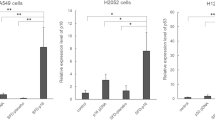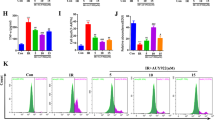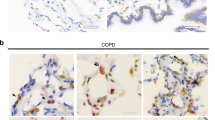Abstract
The long-term survival of lung cancer patients treated with conventional therapies remains poor and therefore the need for novel approaches remains high. This has led to the re-emergence of aerosol delivery as a therapeutic intervention. In this study, glucosylated polyethylenimine (GPEI) was used as carrier to investigate programmed cell death 4 (PDCD4) and PDCD4 mutant (D418A), an eIF4A-binding mutant, on PDCD4-related signaling and activator protein-1 (AP-1) activity in the lungs of AP-1 luciferase reporter mice. After confirming the efficiency of GPEI as a carrier in lungs, the effects of aerosol-delivered PDCD4 were investigated in AP-1 luciferase reporter mice. Aerosol delivery of GPEI/PDCD4 through a nose-only inhalation facilitated the apoptosis of lungs whereas aerosol PDCD4 mutant did not. Also, such aerosol delivery regulated proteins relevant to cell-cycle control and suppressed AP-1 activity. Results obtained by western blot analysis, immunohistochemistry, luciferase assay and deoxynucleotidyl-transferase-mediated nick end labeling study suggest that combined actions such as facilitating apoptosis, controlling cell cycle and suppression of AP-1 activity by PDCD4 may provide useful tool for designing lung tumor prevention and treatment by which PDCD4 functions as a transformation suppressor in the future.
This is a preview of subscription content, access via your institution
Access options
Subscribe to this journal
Receive 12 print issues and online access
$259.00 per year
only $21.58 per issue
Buy this article
- Purchase on Springer Link
- Instant access to full article PDF
Prices may be subject to local taxes which are calculated during checkout






Similar content being viewed by others
References
Schwartz B, Ivanov MA, Pitard B, Escriou V, Rangara R, Byk G et al. Synthetic DNA-compacting peptides derived from human sequence enhance cationic lipid-mediated gene transfer in vitro and in vivo. Gene Therapy 1999; 6: 282–292.
Kim HW, Park IK, Cho CS, Lee KH, Beck Jr GR, Colburn NH et al. Aerosol delivery of glucosylated polyethylenimine/phosphatase and tension homologue deleted on chromosome 10 complex suppresses Akt downstream pathways in the lung of K-ras null mice. Cancer Res 2004; 64: 7971–7976.
Saikumar P, Dong Z, Mikhailov V, Denton M, Weinberg JM, Venkatachalam MA . Apoptosis: definition, mechanisms, and relevance to disease. Am J Med 1999; 107: 489–506.
Göke R, Barth P, Schmidt A, Samans B, Lankat-Buttgereit B . Programmed cell death protein 4 suppresses CDK1/cdc2 via induction of p21Waf1/Cip1. Am J Physiol Cell Physiol 2004; 287: 1541–1546.
Lankat-Buttgereit B, Gregel C, Knolle A, Hasilik A, Arnold R, Göke R . Pdcd4 inhibit growth of tumor cells by suppression of carbonic anhydrase type II. Mol Cell Endocrinol 2004; 214: 149–153.
Yang HS, Jansen AP, Komar AA, Xiaojing Z, Merrick W, Costes S et al. The transformation suppressor Pdcd4 is a novel eukaryotic translation initiation factor 4A binding protein that inhibits translation. Mol Cell Biol 2003; 23: 26–37.
Jansen AP, Camalier CE, Colburn NH . Epidermal expression of the translation inhibitor programmed cell death 4 suppresses tumorigenesis. Cancer Res 2005; 65: 6034–6041.
Wagner EF . AP-1 introductory remarks. Oncogene 2001; 20: 2333–2497.
Young MR, Yang HS, Colburn N . Promising molecular targets for cancer prevention: AP-1. NF-κB and PCDC4. Trends Mol Med 2003; 9: 36–41.
Yang HS, Knies JL, Stark C, Colburn NH . Pdcd4 suppresses tumor phenotype in JB6 cells by inhibiting AP-1 transactivation. Oncogene 2003; 22: 3712–3720.
Jin H, Kim TH, Hwang SK, Chang SH, Kim HW, Anderson HK et al. Aerosol delivery of urocanic acid-modified chitosan (UAC)/programmed cell death 4 (PDCD4) complex regulated apoptosis, cell cycle and angiogenesis in lungs of K-ras null mice. Mol Cancer Ther 2006; 5: 1041–1049.
Tehrani AM, Hwang SK, Kim TH, Cho CS, Jin H, Nah WS et al. Aerosol delivery of Akt controls protein translation in the lungs of dual luciferase reporter mice. Gene Therapy 2007; 14: 451–458.
Densmore CL . Advances in noninvasive pulmonary gene therapy. Curr Drug Deliv 2006; 3: 55–63.
Singhal S, Vachani A, Antin-Ozerkis D, Kaiser LR, Albelda SM . Prognostic implications of cell cycle, apoptosis, and angiogenesis biomarkers in non-small cell lung cancer; a review. Clin Cancer Res 2005; 11: 3974–3986.
Honda T, Coppola S, Ghibelli L, Cho SH, Kagawa S, Spurgers KB et al. GSH depletion enhances adenoviral bax-induced apoptosis in lung cancer cells. Cancer Gene Ther 2004; 11: 249–255.
Lin HI, Lee YJ, Chen BF, Tsai MC, Lu JL, Chou CJ et al. Involvement of Bcl-2 family, cytochrome C and caspase 3 in induction of apoptosis by beauvericin in human non-small cell lung cancer cells. Cancer Lett 2005; 230: 248–259.
Buolamwini JK . Cell cycle molecular targets in novel anticancer drug discovery. Curr Pharm Res 2000; 6: 379–392.
Jin M, Inoue S, Umemura T, Moriya J, Arakawa M, Nagashima K et al. Cyclin D1, p16 and retinoblastoma gene product expression as a predictor for prognosis in non-small cell lung cancer at stages I and II. Lung Cancer 2001; 24: 207–218.
Reddy SP, Mossman BT . Role and regulation of activator protein-1 toxicant-induced response of the lung. Am J Physiol Lung Cell Physiol 2002; 283: 1161–1178.
Maeno K, Masuda A, Yanagisawa K, Konishi H, Osada H, Saito T et al. Altered regulation of c-jun and its involvement in anchorage-independent growth of human lung cancers. Oncogene 2006; 25: 271–277.
Young MR, Nair R, Bucheimer N, Tulsian P, Brown N, Chapp C et al. Transactivation of Fra-1 and consequent activation of AP-1 occur extracellular signal-regulated kinase dependently. Mol Cell Biol 2002; 22: 587–598.
Yang HS, Cho MH, Zakowicz H, Hegamyer G, Sonenberg N, Colburn NH . A novel function of the MA-3 domains in transformation and translation suppressor Pdcd4 is essential for its binding to eukaryotic translation initiation factor 4A. Mol Cell Biol 2004; 24: 3894–3906.
Acknowledgements
This work was partially supported by the grants from the KOSEF (R01-2005-000-10087-0) of the Ministry of Science and Technology in Korea. MHC was supported by the Nano Systems Institute-National Core Research Center (NSI-NCRC) program of KOSEF. SKH, JH, THK are also grateful for the award of the BK21 fellowship. KHL was supported by 21C Frontier Functional Human Genome Project (FG03-0601-003-1-0-0) and National Nuclear R&D Program from Ministry of Science and Technology. GRB Jr was supported by National Cancer Institute Grant CA84573.
Author information
Authors and Affiliations
Corresponding author
Additional information
Supplementary Information accompanies the paper on Gene Therapy website (http://www.nature.com/gt)
Supplementary information
Rights and permissions
About this article
Cite this article
Hwang, SK., Jin, H., Kwon, J. et al. Aerosol-delivered programmed cell death 4 enhanced apoptosis, controlled cell cycle and suppressed AP-1 activity in the lungs of AP-1 luciferase reporter mice. Gene Ther 14, 1353–1361 (2007). https://doi.org/10.1038/sj.gt.3302983
Received:
Revised:
Accepted:
Published:
Issue Date:
DOI: https://doi.org/10.1038/sj.gt.3302983



